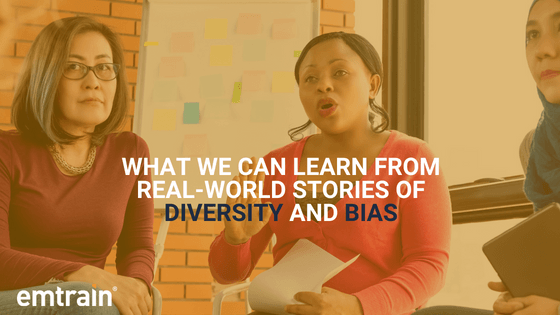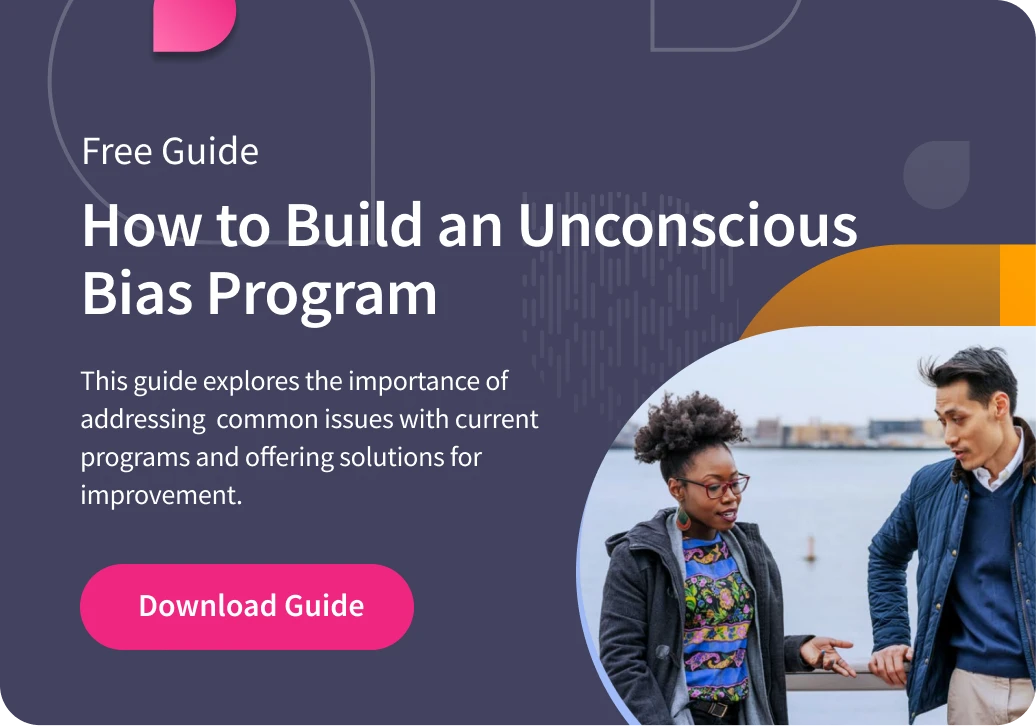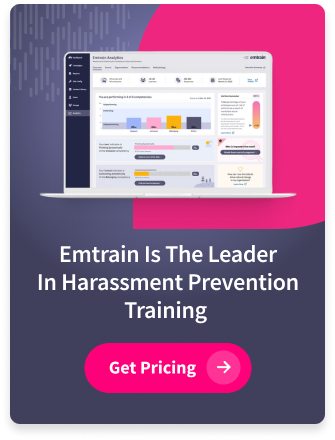As we’ve been helping companies create a more inclusive and diverse workplace with unconscious bias training, we’ve been lucky to accumulate some very rich qualitative data in the form of stories of diversity and unconscious bias that are shared in response to the course material. We think that the thoughtful, safe environment of an online course that encourages an open mindset and nudges behavior change is a primary driver of encouraging participants to share their stories. We also promise anonymity, and this combination seems to make employees particularly open to sharing their personal stories.
The Impact of Diversity Stories: Understanding Unconscious Bias
Personal stories are a particularly important element in efforts to create a healthier corporate culture because stories can impact their audience’s beliefs, attitudes, intentions and behaviors. Stories tend to stay in people’s minds. Whether it’s a board member, an executive, a line manager, or an entry-level employee, someone’s emotional reaction and empathy response to hearing a story from within their own organization carries over into future actions and influences future decisions.
We’ve seen a range of stories from heartwarming to haunting, and share a selection of those stories with you to give a first-hand perspective of how unconscious bias affects the workplace.
Diversity stories in the workplace raise awareness around diversity and inclusion, and belonging in organizations. Workplace diversity increases employee morale, retention, and reduces turnover. Awareness of diversity in the workplace also influences other organizations to do the same internally.
The Positive Side of Bias and Diversity
Although many of the stories that are shared fall under the “what not to do” umbrella, we do often hear real world stories from employees who understand and appreciate the diversity in their organization, even if there’s still some work to do.
Here’s how we’ve heard employees talk about their understanding of why real world diversity is important for business:
“We have diversity in nationality of people where each one comes from a place and a culture that help understand more the diversity of customers we have.”
“Following good discipline of Involving the entire team to make collective decisions and planning helped my team deliver critical projects. Another team I work lacked clarity and less organized with sprint work repeatedly missed delivery milestones and project delays.”
We also hear from employees who seem to just appreciate how great it can be to work in a diverse environment:
“My team has to resolve problems on a regular basis. If everyone thinks alike then they all solve the problem in a similar way and if a problem is seen as difficult then it will be difficult for all team members. A team made up of people that think in different ways solves problems faster with more creative solutions.”
“Each person on our team is different in one way or another and that continually helps us make better decisions. Especially working with some many different cultures everyday.”
There are also employee stories that recognize people with great ideas who may be discounted or ignored because of bias:
“I have a colleague who is extremely smart and offers great ideas and potential. He feels limited by not having a college degree, and that’s a shame, to me, because his ideas and abilities are more thoughtful with potential impact than his peers.”
“Neighboring team member has great ideas. Her team does not listen due to age and background. It is a loss for all involved.”
These stories all highlight the promise and opportunity of true workplace diversity: making better decisions, capturing great ideas—in fact, some recent research shows that inclusive teams make better business decisions up to 87% of the time.
Even the stories of an individual suffering from bias are promising because there’s keen awareness from a colleague that there is an issue. If every organization had employees who were aware in this way and nudged their colleagues to help flag similar cases, they’d be well on their way to creating a healthy culture.
Impact of Diversity Stories on Critical Workplace Issues
Of course, many of the personal stories show issues in areas that we know bias regularly lurks: recruiting, team dynamics and career advancement.
We see problems in specific areas like recruiting:
“A colleague told me about her experience interviewing for a new role internally and mentioned that the interviewer started the conversation by saying that the focus of their interview would be determining “culture fit.” That alarmed my colleague because she is Latina and the interviewer is White, so she immediately felt that she was not going to receive an offer because she is not of the same ethnic background. She felt that she performed poorly in the interview and, ultimately, did not receive the offer. The interviewer may not have explicitly meant that “culture fit” meant White, but her approach brought bias into the interview when it shouldn’t have.”
“Oh. My. Goodness. I worked for a firm where every female candidate who had thoughts was considered a bit too “headstrong and opinionated.” It was clearly gender bias.”
We also hear how challenging it can be for certain people to participate in meetings:
“I have been in several senior management meetings where the number of men far outnumbered the women. In one such meeting, when a woman spoke up, a comment was made to the effect of, “You always have something to say, don’t you?” Although this comment was made jokingly, I did feel it came across as somewhat sexist, albeit subconsciously.”
“One of our most talented analyst was soft spoken in meetings and as a result was not heard. After mentoring, employee gained confidence and offered up ideas and suggestions in a clear and articulate manner”
Bias also makes social interactions in the workplace awkward:
“Most of my colleagues are men, and they seem to want to hang out together all the time. They huddle and laugh about stuff regularly, high-fiving, and hugging. Although they are very nice to me and laugh with me as well, they are much more guarded in conversation, avoiding one on one time in general.”
“Certain people (white) are left out of offsite lunches (Asian). they are not invited to join in.”
Bias can also cause managers to make decisions that impact individuals and the broader team:
“We let go an extremely talented analyst back in June of 2016 because of a perception that he was not focused enough on business value. My sense is that this was the perception of his manager because the manager had come from a business consulting background and the analyst had not. Also, I don’t believe that the analyst had been given this feedback and given an opportunity to address it. I’m not sure if the fact that the analyst was raised in China had an impact on the manager’s perception of him, but it might have.”
“My director, who is otherwise awesome at promoting diversity, only seems to ever ask a couple of my male counterparts out for drinks. This gives them face time with him that I don’t get, and will probably impact my promotional opportunities.”
“A former boss routinely noticed and referred to Asian team members and candidates as such, and also seemed to perceive them differently, with a low level of trust. He also referred to past coworkers that were Asian that he didn’t trust. The same boss also seemed uncomfortable with a gay member of the team. I get the sense that he was not aware of it.”
We see diversity stories of bias in performance assessments, whether it be formal or informal feedback:
“In feedback I’ve seen some comments that seemed like they reflected gender-related bias – for example, I had a female employee who was described as “impatient”. I was uncomfortable taking that at face value and felt that an impatient man would be described as appropriately challenging his team to step up and deliver. Ultimately I took the “impatience” as a positive attribute of my employee, but also gave her feedback that she sometimes shows her frustration more than she intends (which it turns out she had been told before).”
And stories that show how companies send signals about the “right” type of leader:
“A woman in a senior role resigned and was replaced internally by a man; his status, title and role attributes were immediately elevated compared to the prior person-woman in the role, although there is no indication he is more qualified for the role than she was.”
Amongst the comments about unconscious bias, we occasionally see heartbreaking examples of conscious and explicit discrimination:
“I once worked for a company where the general manager interviewed people for a job and ended up throwing the Black candidates applications in the trash basket after they leave, calling it the Black people’s filing cabinet. I felt horrible especially that my desk was right across from him and could tell that some of the candidates he rejected were highly qualified for the job than the ones he chose. Being a minority, I kept it to myself.”
From deeply troubling (and illegal) to subtly off, these stories show varying degrees of bias in the workplace. It’s important to remember that people from all backgrounds and beliefs are present in our workplace. Though our laws and workplace cultures have mostly moved beyond racism, it was not that long ago that candidates of color experienced explicit, broad, and legal discrimination. It was not that long ago women were prevented from or strongly discouraged from holding roles that were “meant for men.” Stereotypes and expectations continue to influence how people are perceived, evaluated, heard, supported and promoted.
Structured processes for recruiting, oversight and awareness around team dynamics, and a focus on management and career advancement can help reduce bias by ensuring a fair assessment on a level playing field. Teaching people about unconscious bias can help raise awareness to root out the more subtle but equally harmful situations.
The Importance of Diversity Stories in Retention Strategies
There are several reasons why we need to explore unconscious bias and bubble up those lingering impressions, stereotypes, and assumptions to our conscious. But perhaps one of the most important reasons is to attract and retain high potential talent.
The more that people, managers, teams, managers, departments, and organizations can learn to recognize and appreciate differences—across gender, race, ethnicity, mental and physical abilities, work styles, and lifestyles—the more inclusive they’ll grow to be. They’ll discover and unlock the potential of their talent in a way that moves the business forward, and create an environment that makes their most talented people feel more engaged, energized and ready to deliver on the next challenge.
Personal stories that are extremely rich in context have the power to influence beliefs, attitudes, intentions, and behaviors, and can help organizations achieve their goals and grow and maintain a strong and healthy culture.
Contact us to learn more about Emtrain’s six-part Managing Unconscious Bias Program.










